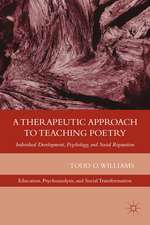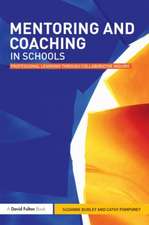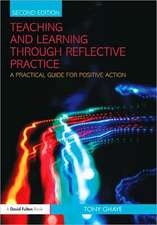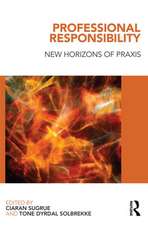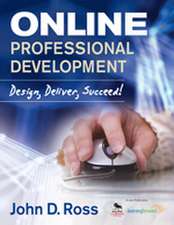The Unified Learning Model: How Motivational, Cognitive, and Neurobiological Sciences Inform Best Teaching Practices
Autor Duane F. Shell, David W. Brooks, Guy Trainin, Kathleen M. Wilson, Douglas F. Kauffman, Lynne M. Herren Limba Engleză Paperback – 2 noi 2014
| Toate formatele și edițiile | Preț | Express |
|---|---|---|
| Paperback (1) | 723.38 lei 6-8 săpt. | |
| SPRINGER NETHERLANDS – 2 noi 2014 | 723.38 lei 6-8 săpt. | |
| Hardback (1) | 729.36 lei 6-8 săpt. | |
| SPRINGER NETHERLANDS – 11 dec 2009 | 729.36 lei 6-8 săpt. |
Preț: 723.38 lei
Preț vechi: 882.17 lei
-18% Nou
Puncte Express: 1085
Preț estimativ în valută:
138.43€ • 143.71$ • 115.43£
138.43€ • 143.71$ • 115.43£
Carte tipărită la comandă
Livrare economică 25 martie-08 aprilie
Preluare comenzi: 021 569.72.76
Specificații
ISBN-13: 9789400791381
ISBN-10: 9400791380
Pagini: 224
Ilustrații: XI, 212 p.
Dimensiuni: 155 x 235 x 12 mm
Greutate: 0.32 kg
Ediția:2010
Editura: SPRINGER NETHERLANDS
Colecția Springer
Locul publicării:Dordrecht, Netherlands
ISBN-10: 9400791380
Pagini: 224
Ilustrații: XI, 212 p.
Dimensiuni: 155 x 235 x 12 mm
Greutate: 0.32 kg
Ediția:2010
Editura: SPRINGER NETHERLANDS
Colecția Springer
Locul publicării:Dordrecht, Netherlands
Public țintă
ResearchCuprins
Developing the Unified Learning Model.- The Unified Learning Model.- Learning.- Working Memory.- Knowledge.- Motivation.- How the ULM Fits In.- Applying the Unified Learning Model.- Classroom Applications Overview.- Supporting Motivation.- Efficient Instruction.- Feedback and Assessment.- A Focus on Thinking.- Encouraging Self-regulation.- Managing the Classroom Environment.- Improving as a Teacher.- Policy.- Frontiers.- Epilogue.
Recenzii
From the reviews:
“This is an excellent book about how learners learn and behave in a classroom and how this understanding about learning could be put to use by teachers for effective teaching. … the authors have successfully tied different ideas, concepts, and theories of learning into one model that is easy to understand even for those readers who do not have a background in education. I highly recommend this well-written and engaging book to all teachers, researchers, and students.” (Sandhya N. Baviskar, The American Biology Teacher, Vol. 73 (4), April, 2011)
“The writers of The Unified Learning Model (ULM) intend their book to satisfy classroom teachers as well as teaching and learning researchers. The book is divided into chapters within two major sections, developing the model and applying the model. … This book reinforced for me the value of modeling and practicing problem solving for students. … It gives the reader a variety of things to contemplate about memoryand learning, the most challenging and enjoyable being the ULM itself.” (Greg Diersen, The American Biology Teacher, Vol. 73 (4), April, 2011)
“This is an excellent book about how learners learn and behave in a classroom and how this understanding about learning could be put to use by teachers for effective teaching. … the authors have successfully tied different ideas, concepts, and theories of learning into one model that is easy to understand even for those readers who do not have a background in education. I highly recommend this well-written and engaging book to all teachers, researchers, and students.” (Sandhya N. Baviskar, The American Biology Teacher, Vol. 73 (4), April, 2011)
“The writers of The Unified Learning Model (ULM) intend their book to satisfy classroom teachers as well as teaching and learning researchers. The book is divided into chapters within two major sections, developing the model and applying the model. … This book reinforced for me the value of modeling and practicing problem solving for students. … It gives the reader a variety of things to contemplate about memoryand learning, the most challenging and enjoyable being the ULM itself.” (Greg Diersen, The American Biology Teacher, Vol. 73 (4), April, 2011)
Textul de pe ultima copertă
This cutting-edge synthesis of ideas and concepts from the cognitive, motivation, and neurobiological sciences sets out a unique theory of learning that should be of interest to everyone from education practitioners to neuroscientists. The authors base their Unified Learning Model, or ULM, on three core principles. Firstly, that learning requires working memory allocation (attention). Second, that working memory’s capacity for allocation is affected by prior knowledge. And finally, that working memory allocation is directed by motivation. These three principles guide a complete model of learning that synthesizes what is known from research in brain function, cognition, and motivation.
This, then, is a book about how humans learn. Its focus is on classroom learning although the principles are, as the name of the book suggests, universal. The text’s scope covers learning from pre-school to post-graduate, as well as training in business, industrial and the military. It addresses all learning described by the word "thought", as well as anything we might try to teach, or instruct in formal educational settings.
The book presents a model of learning that the authors offer as scientists rather than educators. They assert that more than enough is known to sustain a "scientific" model of learning. Rather than being a mere review of the literature, this work is a synthesis. Many scholars and teachers will have heard much if not most or even all of the information used to develop the model. What they will not have come across is a model – designed to be both accessible and usable – that puts together the information in just this way.
This, then, is a book about how humans learn. Its focus is on classroom learning although the principles are, as the name of the book suggests, universal. The text’s scope covers learning from pre-school to post-graduate, as well as training in business, industrial and the military. It addresses all learning described by the word "thought", as well as anything we might try to teach, or instruct in formal educational settings.
The book presents a model of learning that the authors offer as scientists rather than educators. They assert that more than enough is known to sustain a "scientific" model of learning. Rather than being a mere review of the literature, this work is a synthesis. Many scholars and teachers will have heard much if not most or even all of the information used to develop the model. What they will not have come across is a model – designed to be both accessible and usable – that puts together the information in just this way.
Caracteristici
First unifying synthesis of existing theories on learning The authors are able to account for all of the known data about learning Informs about ways to help students learn better



